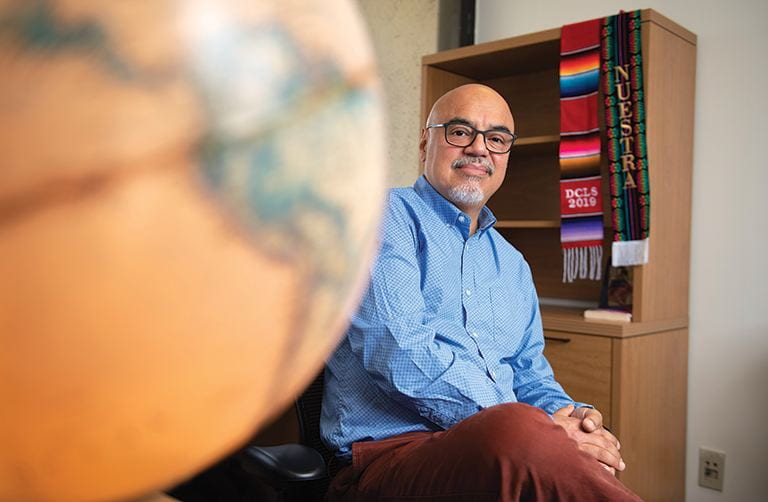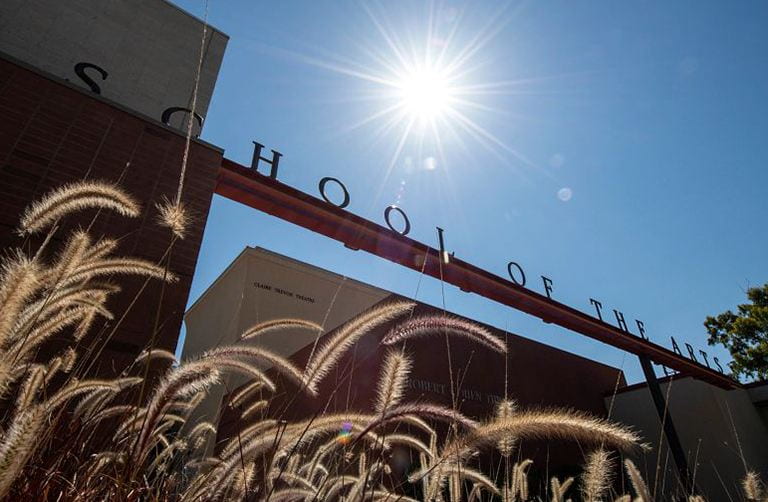On the Road Again: Q&A with Héctor Tobar
UCI professor drives across America in search of its Latino soul
Originally published in fall 2021 issue of UCI Magazine
After loading the trunk of his Volkswagen Jetta with instant oatmeal packets, N95 masks and Tide laundry pods last fall, Héctor Tobar embarked on a 9,000-mile journey across the U.S., visiting various towns for a book on whether the term “Latino” remains relevant in modern America.
Driving through moonlit deserts and mist-shrouded mountains, he encountered colorful characters and fascinating insights. “I’ve always loved road stories,” says Tobar, whose 2020 book, The Last Great Road Bum, fictionalized the true tale of an Illinois college dropout who hitchhiked around the globe before joining a band of guerrilla soldiers in El Salvador.
A former Los Angeles Times reporter who earned an M.F.A. in fiction writing at UCI in 1995, Tobar has authored five books. He’s best known for Deep Down Dark, which chronicled the miraculous 2010 rescue of trapped Chilean miners and inspired the movie “The 33.” In 2017, Tobar joined UCI’s faculty as an associate professor of English (literary journalism) and Chicano/Latino studies.
His new project, tentatively titled A Migrant’s Light: Race, America and the Latino Soul, is a sequel to Translation Nation, his similarly themed 2005 travelogue. Funded partly by a Harvard Radcliffe fellowship, the forthcoming book will probably debut in 2023, he says. A few weeks ago, Tobar spoke with UCI Magazine writer Roy Rivenburg about the evolution of ethnic labels, how the media portray Latinos and the curious migration of Cholula sauce.
Growing up in the 1970s as the son of Guatemalan immigrants, you called yourself a Guatemalan American. In 1980, you’ve said, you checked the Hispanic box on the census. Later, you adopted the Latino label. But you recently wrote that “Latino” and “Latinx” erase your indigenous heritage. So how do you describe yourself now?
I guess I try to avoid the question. The book I’m writing attempts to show how cruel and arbitrary all ethnic and racial identifications are and how they all have roots in histories of exploitation, classism and racism. They were all invented at different times in American history to justify a social order of inequality. When the first colonists arrived in the Americas, they didn’t call themselves white. They called themselves Christians. And the Native Americans were non-Christians or heathens. Once the cotton and tobacco economy got started, the colonists brought in slaves from Africa and invented the ideas of white and black as part of an economic system. I think even “white” is a very cruel term. No one is the color of a piece of paper. And no one is really black; no one is the color of the night sky. There are very dark people, and there are very light people, but essentially, we’re all different shades of brown. So these terms are abstractions.
How did the term “Latino” originate?
In 1850, if your name was Pio Pico and you were the Mexican governor of California, you called yourself Californio, because that was your racial identity. Then, when the U.S. took over, the Californios got called Mexicans. And they didn’t like “Mexicans,” so they started calling themselves Latinoamericanos, which becomes “Latino” in our era. For me, “Latino” is one term at a moment in history. But it isn’t an adequate term.
In an essay for Harper’s Magazine about your recent trip, you wrote: “To call yourself Latino is to resist assimilation, and to be conflicted about who you really are.” But you also said the journey made you feel “more American than ever.” Are those ideas contradictory?
Every time I travel across the country, it really sinks in that the United States is a mestizo country. What the U.S. has become and what it will be from this moment forward is something that has been shaped by immigration from Latin America. There’s all this interplay of language and intermarriage. I’ll give you a stupid example, but a funny one. My daughter loves Cholula sauce. So I recently went to the store, and I couldn’t find it because I was looking in the ethnic condiment aisle. But in many stores, Cholula is now next to the ketchup and mustard because the American palate has changed. It’s a crossover success that symbolizes a larger shift in the culture. So now, at age 58, when I drive through the South or the Pacific Northwest, it’s like, “Wow, I would kind of fit in here more than I would have earlier.”
But still not 100 percent?
No, the perception of Latinos is still very much tied to the border. And it’s really sort of maddening to see so much of the writing about the Latino community focused on immigrant detention, because if you ever talk to someone who’s been in immigration detention, you’re talking about a short period of their life that doesn’t necessarily define who they are. On most days, Latino people find ways to assert their humanity and their intelligence and their ambition through their labor or the way they raise their children. In New York, I interviewed a guy on the street who was shoveling snow. He’s the kind of person I find everywhere when I do a story reporting on the Latino community – but that I never see in the U.S. media – which is the working-class intellectual. My father is that kind of person. Yet the border perception hovers over Latino families.
When do you think that perception might change?
Maybe around the year 2086 – the 100th anniversary of the 1986 immigration reform and amnesty act under Ronald Reagan – the U.S. will start constructing an Ellis Island-type monument run by the National Park Service in San Ysidro or the Sonoran Desert to commemorate all the people who went across or died as they passed through. But for now, that immigration story is still part of the racial fears in this country.



